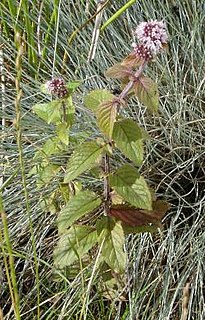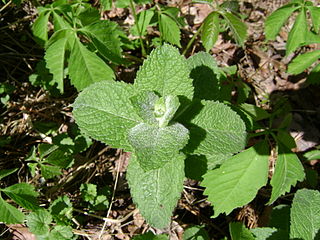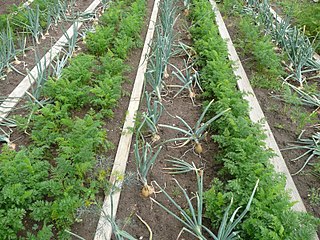
Peppermint is a hybrid mint, a cross between watermint and spearmint. Indigenous to Europe and the Middle East, the plant is now widely spread and cultivated in many regions of the world. It is occasionally found in the wild with its parent species.

Spearmint, also known as garden mint, common mint, lamb mint and mackerel mint, is a species of mint native to the Balkan Peninsula and Turkey. It is naturalized in much of Europe and Asia, in parts of northern and western Africa, North America, and South America, as well as various oceanic islands. Spearmint has two subspecies: Mentha spicata spicata and Mentha spicata condensata (Briq.) Greuter & Burdet.

Altoids are a brand of breath mints. The brand was created by the London-based Smith & Company in the 1780s, and later became part of the Callard & Bowser company in the 19th century. Their advertising slogan is "The Original Celebrated Curiously Strong Mints", referring to the high concentration of peppermint oil used in the original flavour lozenge.

The Royal Mint is a government-owned mint that produces coins for the United Kingdom. Operating under the name Royal Mint Ltd, the mint is a limited company that is wholly owned by Her Majesty's Treasury and is under an exclusive contract to supply all the nation's coinage. As well as minting circulating coins for use domestically and internationally, the mint also produces planchets, commemorative coins, various types of medals and precious metal bullion. The mint exports to an average of 60 countries a year, making up 70% of its total sales. Formed over 1,100 years ago, the mint was historically part of a series of mints that became centralised to produce coins for the Kingdom of England, all of Great Britain and eventually most of the British Empire. The original London mint from which the Royal Mint is the successor, was established in 886 AD and operated within the Tower of London for approximately 800 years before moving to what is now called Royal Mint Court where it remained until the 1960s. As Britain followed the rest of the world in decimalising its currency, the Mint moved from London to a new 38 acres (15 ha) plant in Llantrisant, Wales where it has remained since.

A mint is a food item often consumed as an after-meal refreshment or before business and social engagements to improve breath odor. Mints are commonly believed to soothe the stomach given their association with natural byproducts of the plant genus Mentha. Mints sometimes contain derivatives from plants such as peppermint oil or spearmint oil, or wintergreen from the plant genus Gaultheria. However, many of the most popular mints citing these natural sources contain none in their ingredient list or contain only trace amounts.

Mentha aquatica is a perennial flowering plant in the mint family Lamiaceae. It grows in moist places and is native to much of Europe, northwest Africa and southwest Asia.

Mentha suaveolens, the apple mint, pineapple mint, woolly mint or round-leafed mint, is a member of the mint family Lamiaceae. It is native to southern and western Europe including the Mediterranean region. It is a herbaceous, upright perennial plant that is most commonly grown as a culinary herb or for ground cover.

The Denver Mint is a branch of the United States Mint that struck its first coins on February 1, 1906. The mint is still operating and producing coins for circulation, as well as mint sets and commemorative coins. Coins produced at the Denver Mint bear a D mint mark. The Denver Mint is the single largest producer of coins in the world..

Prostanthera, commonly known as mintbush or mint bush, is a genus of flowering plants of the family Lamiaceae. There are about 90 species within the genus, all of which are endemic to Australia. The word is derived from the Greek for an appendage. Within the flowers are small spur-like appendages on the anthers.

Monarda citriodora is a species of flowering plant in the mint family, Lamiaceae, that is native to much of the United States and Mexico. Common names include lemon beebalm, lemon mint and purple horsemint. When crushed, the leaves emit an odor reminiscent of lemons. This odor is sometimes described as more resembling oregano, especially late in the season. Its purple flowers are highly attractive to butterflies, bees and hummingbirds.

Agastache is a genus of aromatic flowering herbaceous perennial plants in the family Lamiaceae. It contains 22 species, mainly native to North America, one species native to eastern Asia. The common names of the species are a variety of fairly ambiguous and confusing "hyssops" and "mints"; as a whole the genus is known as giant hyssops or hummingbird mints.

Mentha arvensis, the corn mint, field mint, or wild mint, is a species of flowering plant in the mint family Lamiaceae. It has a circumboreal distribution, being native to the temperate regions of Europe and western and central Asia, east to the Himalaya and eastern Siberia, and North America. Mentha canadensis, the related species, is also included in Mentha arvensis by some authors as two varieties, M. arvensis var. glabrata Fernald and M. arvensis var. piperascens Malinv. ex L. H. Bailey.

Kailyard redirects here. For the grouping of Scottish literature see Kailyard school

The Japan Mint is an Independent Administrative Institution of the Japanese government, responsible for producing and circulating the coins of Japan. The agency has its head office in Osaka with branches in Tokyo and Hiroshima. The Japan Mint does not produce paper money; that responsibility belongs to the National Printing Bureau.

Pycnanthemum tenuifolium, the narrowleaf mountainmint, slender mountainmint, common horsemint or Virginia thyme, is a plant in the mint family, Lamiaceae. It is native to eastern North America.

Monarda punctata is a herbaceous plant in the mint family, Lamiaceae, that is native to eastern Canada, the eastern United States and northeastern Mexico. Common names include spotted beebalm and horsemint.

Blephilia ciliata is an herbaceous perennial of the mint family Lamiaceae native to eastern North America. It is commonly called downy wood mint. Other common names include downy pagoda plant, sunny woodmint and Ohio horsemint.

Yerba buena or hierba buena is the Spanish name for a number of aromatic plants, most of which belong to the mint family. Yerba buena translates as "good herb". The specific plant species regarded as yerba buena varies from region to region, depending on what grows wild in the surrounding landscape, or which species is customarily grown in local gardens. Perhaps the most common variation of this plant is spearmint. The term has been used to cover a number of aromatic true mints and mint relatives of the genera Clinopodium, Satureja or Micromeria. All plants so named have medicinal properties, and some have culinary value as herbal teas or seasonings as well.




















